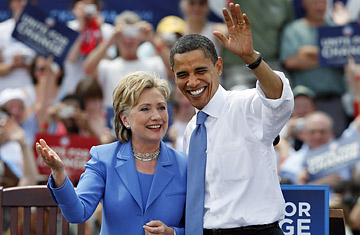
Democratic presidential candidate Barack Obama and Senator Hillary Rodham Clinton, greet the crowd at a campaign event in Unity, N.H.
In truth, we could end this story right here. You have the photograph up top of Barack Obama and Hillary Rodham Clinton, victor and vanquished, all smiles and full of shared purpose. He says she "rocks." She says they used to be "toe-to-toe" but now they're "shoulder-to-shoulder." And you have the name of the town, which is the whole point of the exercise: Democratic party unity prevails in picturesque Unity, N.H.
The perfect political photo op — and this was a pretty darn good one —isn't aimed at the rational faculties of an informed electorate. It seeks whatever section of the brain it is that triggers a tummy rumble at the sight of a moist doughnut. It's about instinct, not reason.
But there's more here than meets the eye, so we'll keep going. Start with the simple fact that a truly unified political party doesn't need a unity rally. It's a long, slow bus ride down a winding two-lane road, over hills, through pines and pastures, to reach this remote New England village. The fuel that drives the bus is worry, and the worry stems from division.
And of course they have divisions. The Democratic nomination battle was one of the most close-fought in modern American history. "We had some spirited dialogue," Clinton told a crowd of perhaps 4,000, with a wry twist on the word "spirited." She paused for the laughter, and added: "That was the nicest way I could find to put it."
By the end of their coast-to-coast, January-to-June combat, millions of voters had skin in the game — their dreams of a woman President, or a black President; their hopes of restoring the Clinton dynasty, or their hopes of ending it; perhaps more prosaic investments in an Administration post, a consulship in a nice European burg or just a friendly ear in the White House. Politics is not just about instincts and ideologies — it's also about interests. And the winners get a bigger share of the satisfaction than the losers.
That's why, as the New York Times reported earlier this week, the days leading up this public display of unity have been filled with a lot of private hardball, with Washington, D.C., dealmaker Robert Barnett negotiating between the Obama and Clinton camps to rearrange the spoils in a way everyone can live with. Clinton staffers need jobs, Clinton vendors need to be paid, Clinton egos need to be stroked.
What does Obama need? The master pol Lyndon B. Johnson once cut to the essence of unity in a divided party when he said he preferred to have his foes inside his tent, um, relieving themselves outward, as opposed to outside pointing in.
Clinton's speech was effective in part because she didn't pretend otherwise. The photos said lovefest — his tie matched her suit and his arm was around her like Donnie and Marie — but her words subtly signaled that she was entering the tent of a once (and possibly future) rival solely to concentrate fire outward. She reminded a crowd long on anti-war voters that only three times in her 40 years of political life has a Democrat won a presidential election. "We cannot let this moment slip away," she said emphatically.
Even the woman in the back who started the rally loudly hooting Obama and shouting "We Want Hillary!" fell silent while contemplating that data point.
The wounds from a fight like this one don't vanish overnight. Former President Jimmy Carter still bristles at the mention of Sen. Edward M. Kennedy, who challenged Carter in 1980, fought to the end and — at least in Carter's version of events — cost him a second term. That's 28 years. This one hasn't been over for 28 days.
But if Barack Obama can make the same deal with Clinton's supporters that he evidently is reaching with her — if he can persuade them that the real enemy of their ideals and interests is the one outside the tent — then today's photo op will last past dinner time.
